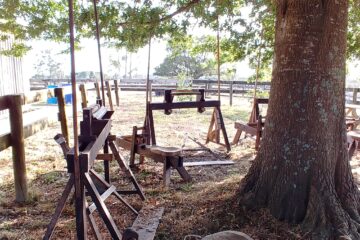Day four was a morning of sewing. Sue had fine tuned the older Singer sewing machine, and as it was slower, it was a easier machine to use, and allowed for bit more control. It still took a bit of getting used to, and I wasn’t always as competent or comfortable using this machine as I was using some of the tools. This speaks a lot to my background of tool usage, and my foot. A sewing machine uses a combination of hands but includes using the foot, which for me is a unusual tool using limb. In fact the only time I use my foot for tool control is driving a car, and that can be hard work unless I position myself well. Its all about getting my foot angle right so that I can use the range of motion in my ankle that I have. Otherwise I would be using my leg or toes. (I will get a diagram in here to explain this at some point.) So it is possible that with a bit of faffing around, and work bench height adjustment, and seat manoeuvring I could have gotten into a better position to manage the sewing that accommodated my line of sight, my range of foot motion, my hands, and possibly my back as well.
That all said, practice is the key, and if I was doing something like this again, I suspect that prior sewing on a machine would be useful. Its curves that’s the tricky bit. There is that moment when one tracks a curve when lifting the machine’s foot, pivoting on the needle, and then continuing, might be an option, as opposed to pulling the material round. That appears to be a moment to learn. Oh well.
For people who sew a lot, my guess is that their muscle memory would probably adapt to the new machine fairly quickly? Maybe. With ‘clicking’, I found myself shifting my grip and knife to a more vertical position which wasn’t ideal. I had to be constantly reminded, either by Sue or myself, to drop into a deeper more slanted angle of attack for the cut. There was a similar problem for the for skiving tool: I could grip, eye the tool etc, but the idiosyncrasies of the particular tool and its use needed attention. So I could ‘muscle memory’ some of the physical action, but had to pay attention to other bits.
My guess is that for an experienced sewer a new machine would pose similar issues of focussing on some aspect of the machine use that was new, while muscle memory and habits would look after the rest. Identifying the point of focus might well be the skill required, which may require a reflective practice. So one might need to know that in dealing with a new hand tool, understanding the needed angle of attack is important. Ditto something for using a new sewing machine.
I will get some photos up showing the results of my stitching, shortly. Mostly is was okay, but there were bits that were a bit marginal, and spoiled the line of the brogue seems in particular. So they weren’t quite as perfect as one might like.
The rest of the day was assembly preparation, plus a bit of “lasting,” right at the end of the day. The lasting is the final process. It is only there to sit there, and do some planning and organisation. As you can see from the photos, this temporary last does give some ideas about the shoe, and one might want to make some changes at this point to various details like eyelets, etc. Its the first real look at how the shoe is going to look.
I suspect day five is going to be a lot about lasting.



0 Comments